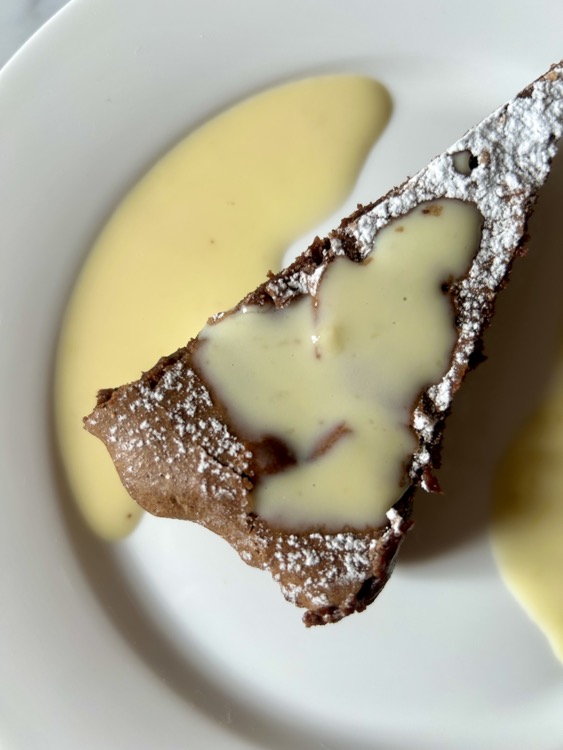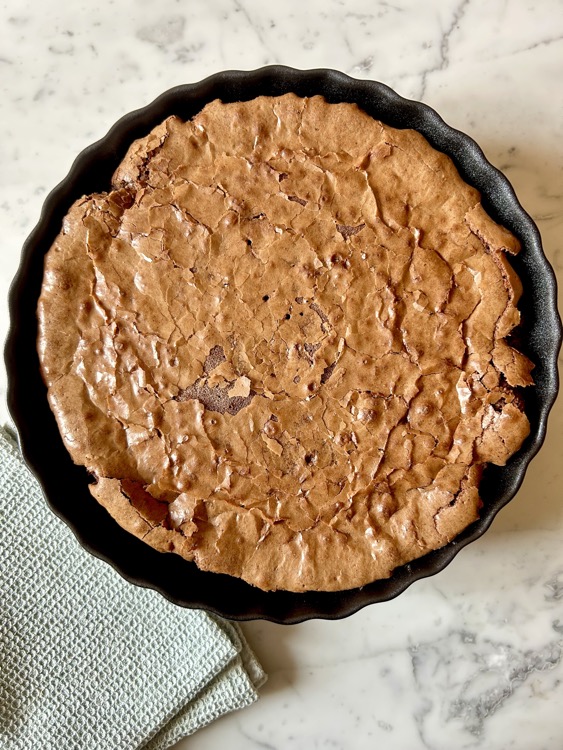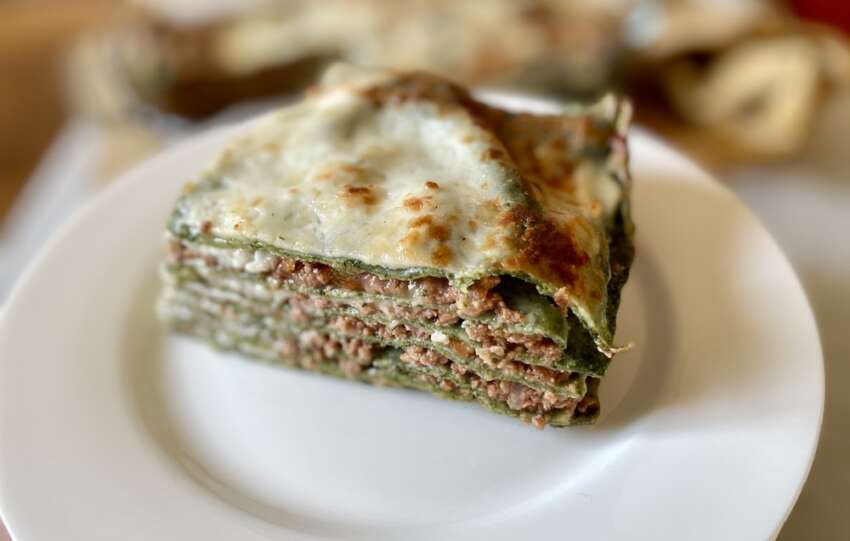I arrange the ingredients on the table: fresh eggs from the countryside, dark chocolate, powdered sugar, flour, butter, and salt. That’s all you need for Tenerina Cake.
Some dishes make you travel into the past. And like Proust’s Madeleine, they are tickets to a nostalgic tour aboard the Orient Express. The bar of dark chocolate I hold in my hands looks like a travel card ready to be obliterated.
Let me tell you that Tenerina is a dessert that I rarely ate as a child.
It is a recipe that belongs to my adult life when, as a University student, I used to organize convivial moments with friends and classmates.
It was a dessert that was always a great success. Who doesn’t like chocolate?

Chocolate and home rules
Throughout my life, I have met more lovers than critics of chocolate, I mean. And while I don’t despise it, you may be surprised to know I hardly ever eat it.
There were rules at home: candy and chocolate rarely, soft drinks not even to speak of. The prohibitions left a mark. A thread of subtle indifference ran between me, chocolate, and soft drinks.
Exceptions were valuable allies in escaping such stringent prescriptions.
At Easter, I used to receive many chocolate eggs.
But the chocolate feast lasted only a few days. Then mom would say, “Little girls can’t eat all that chocolate.” And the chocolate would disappear.
School parties and classmates’ birthdays were also occasions to indulge in forbidden foods.
With my glass of bitter orange soda, of which I savored every drop, I would go through the trays. I loved the small bignè, the one-bite ones, with the cream exploding in your mouth. And then the pizzas and the gourmet savory panettone.
I have always had an interest in cakes.
I appreciated the ice cream ones (take a look at the one I make without the ice cream maker), another food subjected to strict rationing, and the multi-layered ones, especially when filled with chantilly or buttercream.

Home cakes
In the early part of my life, I could eat, above all, homemade sweets.
There were desserts that Grandma executed masterfully: croquembouche, Montebianco, chocolate pudding, Sicilian cassata, Paris-Brest, and special tiramisu (her version, not any tiramisu. A recipe that, indeed, I almost always find sweetly monotonous).
And, especially, there were cupboard cakes: ciambelle, crostate, and cookies.
I still have a huge passion for a well-executed tart and a distinct preference for the apricot jam with a slightly sour aftertaste. The absolute best from my childhood was that of Lea, the beloved -even by me- grandmother of Claudia, my best friend throughout elementary school.
What about chocolate desserts?
Of the Profiteroles, I loved the whipped cream. Even with Christmas Pudding and Tenerina Cake, I appreciated the company more than the cake itself: whipped cream, again, or slow, voluptuous English cream.
I admit that Grandma Sara is a good Tenerina. Everyone who tastes it says it is remarkable.
Grandma Sara was an appreciator of ricotta and chestnut flour. They were two ingredients she used often. And the latter was, in her opinion, her coup de maître.
“If you want to give chocolate a boost, add a spoonful of chestnut flour,” she used to say. Well, she also used some potato starch but never wheat flour which, for Grandma, disturbed the final result.
“Tenerina cake has to taste like a chocolate praline and melt in the mouth.” And with a snap, she would close the oven door and the conversation.

Tenerina cake, a typical recipe from Emilia-Romagna
Along the cities of the Via Emilia, food is a serious thing. And it is the subject of heated debates.
Take the Tenerina Cake. Several cities in Emilia-Romagna, besides Ferrara, even Bologna and Forlì, claim its creation in honor of Queen Elena Petrovich of Montenegro, who married the King of Italy, Victor Emmanuel III.
According to this theory, the cake is born in the late 19th and early 20th centuries to celebrate the haughty-looking queen’s tender heart.
Before writing this post, I did a long research without finding any evidence to support this story. Another less romantic and more practical anecdote claims the dessert originated in the second half of the twentieth century as a homemade recipe to reuse chocolate from Easter eggs.
In those years, patissier Eugenio Gollini from Vignola, a village close to Modena, invented the Torta Barozzi and registered the trademark making the recipe secret. Again, in a small town in the Bolognese area, a lady offered some cookies, known today as the King’s Biscuits, to King Victor Emmanuel III, and we also know her name and surname.
Cosa voglio dire? Che se la torta fosse stata inventata per la Regina d’Italia io credo che conosceremmo l’identità del pasticcere. Il fatto che sia sconosciuta fa pensare più a una brava e ingegnosa cuoca di casa.
Ma non voglio sciupare la poesia del racconto. E che importa se è solo una delle tante possibili storie cresciute all’ombra del grande albero della Storia.
Buona cucina, Monica
Traditional sweets from Emilia-Romagna
In addition to Tenerina Cake, chocolate (and coffee) themed is Torta Barozzi, a gluten-free cake created in the late 1800s by Eugenio Gollini, an avant-garde pastry chef from Vignola (Modena). On the blog, you will also find a recipe for a dessert that has been a favorite of the Bolognese since the 1400s. It is Bologna’s famous Torta di Riso whose flavor reminds me, even if the ingredients are different (for example, there is no rice), of Vera Torta, a specialty of the city of Imola alone (a small town of Romagna culture located in the province of the Bologna city). Another popular dessert is Portuguese Milk (or Fiordilatte using the Bolognese name). Whatever the name, it is an ancient and highly satisfying spoon dessert. Finally, as famous as it is good, I recommend you look at the recipe for Tagliatelle Cake, Ferrara-born like Tenerina.

Food Tips
Make it the day before and store it in the refrigerator.
If you don’t have chestnut flour, use 40 g of potato starch.
Tenerina Cake (Gluten-free Recipe)
serves 6-8
round mold diameter 25cm
Ingredients list
dark chocolate, 200g
powdered sugar, 180g
butter, 180 g
regular eggs, 5
potato starch, 20 g
chestnut flour, 20 g
salt, a pinch
to decorate: powdered sugar
Method
Melt butter in a saucepan over low heat. Add the chopped chocolate, stir, and mix. Turn off the stove, and let it cool almost completely.
In a bowl, combine and mix potato starch and chestnut flour with a pinch of salt.
Separate the yolks from the egg whites and whip the latter until stiff. Set aside.
Beat the yolks, powdered sugar, and flour.
Add half of the beaten egg whites, incorporate gently with a spatula, and then add chocolate to the mixture in three steps. Each time you pour in the chocolate, incorporate stirring gently.
Finally, add the leftover whipped whites and mix as well.
Pour the batter into a cake pan lined with baking paper or greased beforehand, and bake in preheated oven at 180C degrees for 20 to 25 minutes.
Open the oven door (not all the way) and let the cake rest for 5 minutes before taking it out of the oven and letting it cool completely.
Dust with powdered sugar, cut into slices and serve on its own or with whipped cream, ice cream, or custard. You can also accompany it with fresh strawberries.







